The choice of a luminaire for the kitchen is based on the area of the room and depends on the tastes and preferences of the owners. An important role is played by ease of use. About how not to get lost in a huge assortment of kitchen lighting fixtures, than to be guided by the purchase, we will discuss this article.

Features
Lighting in the kitchen is different from lighting in the living room or bedroom. Therefore, the choice of ceiling lights in the kitchen should be approached with particular responsibility. Before buying fixtures in the kitchen, you should determine the area of the room and the height of the ceilings. And also it is necessary to choose the type of lighting for each zone. It is of three types:
- diffused lighting scatters the luminous flux throughout the room;
- directional - implies a point light stream strictly down or to a specific area of the kitchen;
- reflected - this is the reflection of light from the ceiling over the entire area of the room.


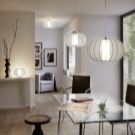



Lighting in the dining area of the kitchen should be diffuse, warm or neutral in color. The shade of lighting affects the visual perception of the environment and objects. For example, the cold light of the lamps distorts the colors, which makes the shades of dishes and products unnatural. White cold light can only be used as a decoration for the workspace. Saturated warm color is also not suitable for the kitchen. It reduces tone and creates a lethargic mood. Neutral or moderate yellow light, on the contrary, gives vitality, fills with energy and calm, which is very important in the processes of cooking and eating.



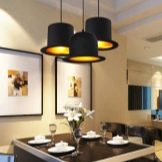
Light should not be dim or dazzle. It is worth noting several nuances of lighting in the kitchen.
- The entire area should be evenly lit. In this case, it is worth paying attention to the ceiling models made of glass. They have the highest light transmission coefficient. The luminous flux is scattered throughout the area and illuminates all areas.
- Shadow areas should not occur, especially within the work and dining areas.
- Lamps are placed so that the light does not hit the eyes and does not create glare and shadows.

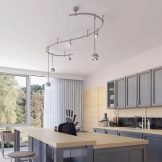


To ensure optimal bright light, you should correctly select the power of the lamps, given the number of lighting devices. The more fixtures, the lower the power consumption of one bulb. And also when choosing kitchen lighting, you should pay attention to the decoration of the room. Beige, white shades reflect up to 80% of the light, all dark tones - 12%.
Species overview
The variety of assortment of fixtures for the kitchen is very large. Of the hanging options, it is worth noting kitchen chandeliers. This is a classic example of lighting. Chandeliers come in various shapes and sizes: Ceiling, mounted, multilevel, volumetric, with different light directions and adjustable lamp direction. The number of bulbs depends on the model. As a rule, for a medium-sized kitchen, chandeliers with two or three bulbs are chosen. The main lighting can be supplemented by several models of built-in type.




Overhead lights with a glass casing - the easiest form of lighting. As a rule, such lamps are produced under several bulbs, for example, there are models for 4 or more lamps. For the kitchen, a lamp with three lamps is best suited. Since the entire structure is in plain sight, special attention is paid to the design of the ceiling. Glass models look best. They can be of various shapes and colors. The glass surface is painted with various patterns. The choice of models is diverse.
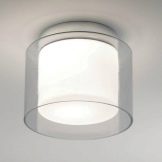



Overhead lights can be square, round or oval. Glass can be transparent, frosted or partially frosted. The choice is based solely on individual preferences and lighting area.
Spots - small size fixtures with a movable base. Most often, the spots are round. Using a movable base structure, it is possible to adjust the directional light, which is a very convenient option when lighting a work or dining space. When decorating the kitchen with spot lamps, the kitchen looks modern and original. Lighting devices with LED strip inside are also in great demand. LED lamps exist in several types:
- overhead models;
- point devices;
- railing models;
- pendant lights.




Overhead LED Models are lamps, inside of which there is an LED strip. The body (cover) is most often made of plastic. The power of such lighting is different and is selected based on the area of the room. Such lighting is suitable for kitchens with low ceilings, as the lamp is mounted directly under the ceiling. In addition, the life of the LEDs is quite high: the minimum life of 7 years. All types of LED lighting consume little electricity, which makes models of this class the most popular among consumers.
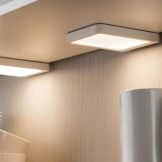
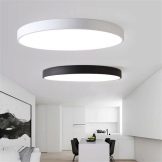


Spot models are a type of local lighting. The choice of size and power of devices is based on the area and interior of the room. Several appliances are enough to illuminate the entire space of the kitchen.
Railing models designed to highlight the working area of the kitchen. Mounted by mounting on a special frame or on the bottom surface of wall cabinets. Pendant LED models are a construction of one or more LED panels on cables, with which you can adjust the height.Suspended models with LEDs exist in various shapes and sizes: circles, lines, intricate shapes, flat panels and linear lamps. As a rule, pendant LED models are used to illuminate a large space.




Lamps on the bus. Such models are designs with several lighting devices that look like a flashlight or spotlight. The lamps are placed on a special bus, which is built into the ceiling. Some models have advanced functionality and suggest the movement of lamps along the frame, which helps to regulate the degree of direction of light.




And also exist mortise models and fixtures in the form of suspensions. The body of the mortise device is recessed and hidden in the ceiling, the body in the form of a lighting panel remains outside. This design is considered an addition to the decor of the kitchen and looks very stylish. Suspended models, as a rule, are used in the design of a kitchen in such stylistic directions as a loft, fusion or techno. The luminaires are suspended on a common base and mounted on the ceiling using a special mount.




Lighting panels are most in demand in the design of a modern kitchen. To ensure good lighting, a pair of medium-sized models are placed on the ceiling in a certain pattern. A large panel measuring 60x60 cm is mounted in the center. The device perfectly illuminates the space and does not look bulky at the same time.
Criterias of choice
As a rule, the choice of a lamp for the kitchen is based on the height of the ceiling of the room. At low heights, it is worth choosing the following models: ceiling chandeliers and flat lamps, spots, spot and overhead models. With a rather high ceiling height, a volumetric type of fixtures is chosen. So, for haute cuisine, voluminous chandeliers, pendants, railing models of varying degrees of complexity are suitable.


Different types and forms of construction can visually expand or, conversely, narrow the space. Therefore, a combination of several models of various parameters is considered the best option for lighting design. For a large room, a combination of suspensions and overhead structures is suitable. You should also consider the type of interior. Fashion is constantly changing, it is becoming increasingly difficult to choose the best lighting option.


You can choose a lamp for the kitchen based on the finishing material of the ceiling. Drywall ceiling is styled with LED panels, spot models or spots. Suspended chandeliers or mortise fixtures are more suitable for wooden ceilings. For suspended ceilings, a combination of suspensions and mortise models is suitable. When designing a stretch ceiling, it should be borne in mind that the glossy surface reflects light. Therefore, the number of lighting points is doubled visually.


Placement Recommendations
When placing fixtures, the location of the working space and dining area should be taken into account. If the dining table is located in the central part of the kitchen, then one lamp is enough on the ceiling. The original option will be a lampshade, matched to the interior of the room. When the dining tabletop is located near the wall, a combination of several light sources can be placed on the ceiling. For example, in the center of the ceiling, the lampshade or overhead lamp will look stylish. Spotlights can also be placed above the countertop and workspace. The luminous flux of scattered-type point structures is able to illuminate the entire space.


With the main lighting turned off, spotlights can be used as backlights.
To properly position the lamp above the dining table and workspace, you can resort to a few design tips.
- When choosing a hinged lampshade, it is worth considering the height of the room.
- When lighting the space above the table, a closed lampshade is used.Light should not shine at one point. Lighting should be diffuse.
- Lighting in the kitchen should be warm, yellow. Cold light should be avoided, since cold light distorts colors and dishes will not look so appetizing.
- The hanging lamp must have a height adjustment. If necessary, this allows you to lower or raise the lamp above the countertop.
- A dimmed lamp will help to adjust the power of the bulb. However, you should be aware that only special dimmed lamps are suitable for dimmed devices, which are distinguished by their high cost.


At low ceilings, do not abandon lampshades or suspensions. The main thing is that the distance from the table to the point of the lower base of the lamp is no more than 65 cm. The distance of 160 cm is considered the maximum. Lampshades and shades of elongated shape visually increase the height of the room and look great in rooms with low ceilings. The best solution would be a model with two or three bulbs and with adjustable light direction.


One lamp can be adjusted in the direction of the working area, the second - to direct to the dining table, with the help of the third lamp you can illuminate the central area of the room.
Beautiful examples
Make the right choice will help examples of design with a description. Option with a chandelier in the central part of the room. This design is perfect for large spaces. In combination with a chandelier, it is possible to install additional lighting in the form of spot lamps or spot models.


Placement of several hanging models above the table. Several suspensions can be placed directly above the dining space. Luminaires need to choose medium sizes. It is also worth considering that the more suspensions, the smaller the size of the lamps.
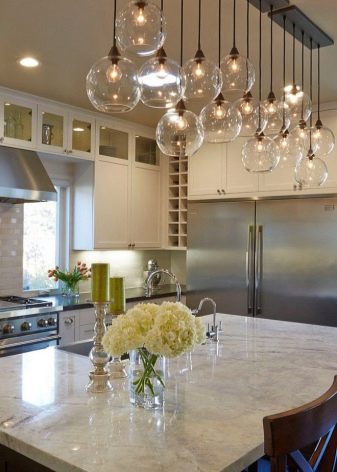

Several point structures separate the workspace from the dining area. The layout depends on the style and configuration of the kitchen. To well illuminate the room, you need to choose a sufficient number of lamps. To ensure good lighting, the number of appliances is determined based on the area of the kitchen.


When choosing lighting, you should pay attention to the multi-level design of the ceiling. This type of lighting involves the placement of various types of lighting devices. However, it is worth following a few rules.
- The multi-level lighting is present for the original solution rather than for lighting. It is located on the sides of the surfaces of kitchen furniture and cabinets.
- Point instruments are located on flat surfaces around the entire perimeter and in the niches of the ceiling.
- The dining area is decorated with suspensions.
- Lighting panels are mounted flush with the ceiling.


See how to choose the right ceiling lights for the kitchen in the next video.










